Foreign Insulators
by Marilyn Albers
Reprinted from "Crown Jewels of the Wire", December 1995, page 31
NEW CD NUMBERS ASSIGNED TO
GLASS INSULATORS FROM ARGENTINA!
If you read the great article about the ‘P. WALTERS & CO.’ insulator
in the November issue of Crown Jewels of the Wire, you are already aware that
our famous travelers Bernie Warren and Jim Bergman (Anchorage, AK) made a second
trip to Uruguay and Argentina. For three weeks, from late August through the
third week of September, they followed all the major highways and drove down
every country road looking for insulators. In the process they discovered some
new glass and porcelain styles in Argentina, and have kindly allowed me to
include them in this month’s article. The photo below shows three examples of
CD 101.6, the new number assigned to this telephone style. The insulator in
clear glass on the left was first seen in 1992. This one is on loan from another
collector whose father brought it back to him as a gift from Argentina.. The
insulator in the center is a straw color. Bernie found this one just lying on
the ground but never saw any others like it, so it is the only one known at this
time. The piece on the right is unembossed but is a beautiful bubbly sage green.
Bernie and Jim discovered only two of these on old abandoned poles. They saw no
other CD 101.6’s on working lines during the entire time they were in
Argentina. I am fairly certain that at least one of the insulators, the clear
one, was produced by a glass manufacturer in Buenos Aires known as CRISTALERIAS
RIGOLLEAU, which could explain the letters ’C.R.’ in the embossing.
|

|
|
Far Left: |
One half-mold |
Opposite half-mold |
|
C.R.
INDUSTRIA ARGENTINA |
2 |
|
Center: |
One half-mold |
|
|
INDUSTRIA ARGENTINA |
|
|
Far Right: |
No embossing |
|
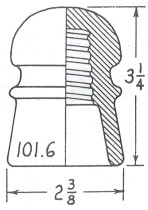
The next photo is of a CD 107 in light straw. Our travelers found only two of
these, one with embossing and one without. CD 107 is not new to collectors
because it is easily recognized as a style made by insulator manufacturers in
America and Mexico, but it is a new listing for foreign glass. Notice that the
embossing includes a 1979 date of manufacture, which indicates that the
insulator is less than 20 years old. Unfortunately, we have no information on
the SILMINAR company, but I’m sure further research will bring us the answer.
Bernie and Jim may be packing their bags as I write!!
|
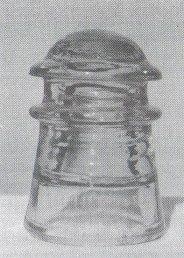
|
|
One half-mold
SILMINAR S.A.
IND. ARG. |
Opposite half-mold
1979 |
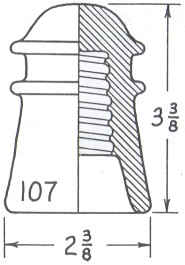
AND STILL ANOTHER
FROM URUGUAY!
Two variations of a tiny glass “spool” insulator have been just been
classified as new CD 1096. Before Bernie straightened me out, I would have bet
my last dollar that these were used as electric fence insulators (seems like
they’d work just fine!). In regard to the one on the left in the photo, he
says “Jim and I found several spools in straw colored glass which “were
remnants of an old telephone line with short sections of wire hanging at odd
poles.” All of these are unembossed products of the CODARVI Glass Factory in
Montevideo. This style was also made in clear glass, but only two examples are
known at this time.
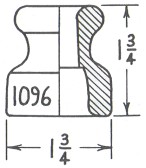

The insulator on the right in 7-up green glass is a CD 1096 variation of the
straw spool. Even though the two have slightly different profiles, N.R. Woodward
didn’t feel the difference was enough to warrant a new CD. The NV spool was
made by Sociedad Anonima Fabrica Nacional de Vidrio, (“National Glass Factory,
Inc.”), located near Montevideo. While most insulator styles produced by this
glass factory are embossed S.A.F.N.V., several (including this new one) have
been found with just NV (“National Glass”) in either upper or lower case
letters. I want to believe that the NV embossing shown below is more recent than
the S.A.F.N.V., but my intuition falls far short of proof.

One half-mold
ARGENTINA YIELDS NEW
STYLES IN PORCELAIN
During their time in Argentina, Bernie and Jim managed to scarf up a number
of porcelain insulators. Some of these are shown in the photos below. All await
new U-numbers. Notice the CD 101.6 “look alike”!
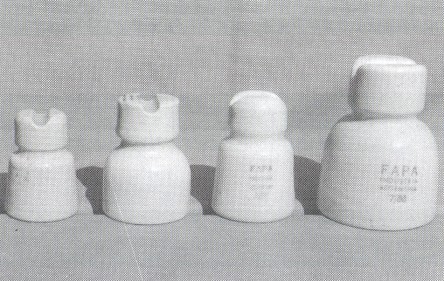
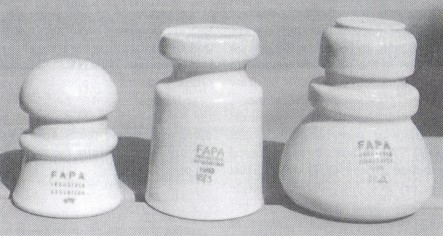
These pieces are glazed white and range in height from 2 inches for the
shortest piece to the tallest one at 4-1/4 inches. Six are marked with a
production date, including (19)75, 77, 79, 88, 89 and 93. There is no visible
date on the smallest insulator. Four variations of the FAPA underglaze ink
marking can be found among the seven styles.
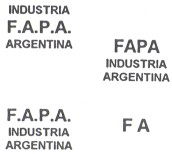
The porcelain factory that produced the insulators is known as FAPA (Fabrica
Argentina de Porcelanas Armanino S.A.I.C.) and is located in Buenos Aries.
Miroslav Immer, our insulator expert in the Czech Republic, has condensed some
information from his 1982 FAPA catalog and passed it along to us: “Fifty years
of experience and the increasing role of research and development are the
basement over which FAPA pursues its technological improvement. This spirit
still remains from the manufacturing of the first insulator in our country to
the introduction into the national market of our latest products: toughened
glass suspension insulators and composite insulators of polymer-porcelain. Raw
materials are obtained from our own mines. Our employees number 350 and our
plant site and mines occupy nearly 40 acres of land. The current production line
includes pin types, “toughened glass” suspension insulators, eggs, supports
and bushings”. According to Miroslav, FAPA also has a glass factory in Monte
Grande, supposedly somewhere near Buenos Aires, but it is not clear if the glass
suspension insulators are made at this site or only assembled there, using glass
shells supplied by SEDIVER of France. Shown below is the marking on the iron cap
of a suspension insulator supplied by FAPA. Also included is a fifth (and
modern?) variation of the FAPA trademark taken from Miroslav’s catalog.
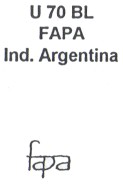
| 